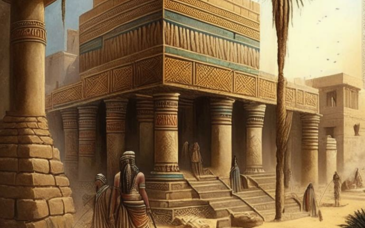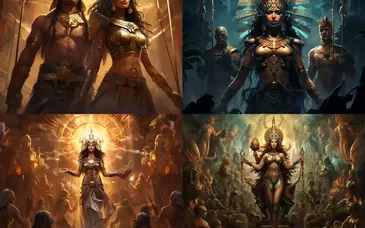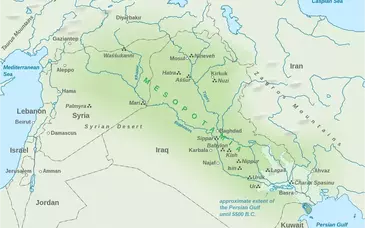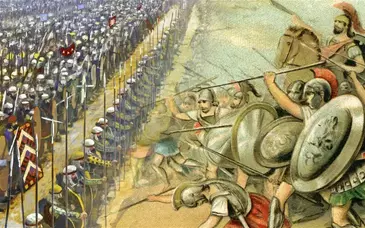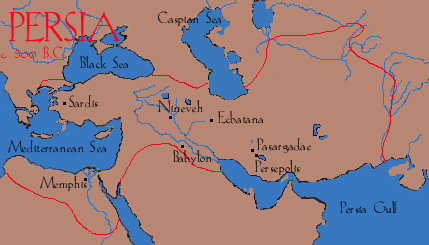
A Brief History
The land known as Persia quickly grew from a small vassal state to the world's first great empire. The first inhabitants of Persia arrived c. 6000 B.C. from central Asia. An influx of Aryans from the Caucasus Mountains c. 1000 B.C. resulted in the formation of two kingdoms: the Kingdom of the Medes and the Kingdom of Parsa ( Persia ).
The lineage of the Persian kings is traced back to Achaemenes who ruled c. 700 - 675 B.C. He was succeeded by Teispes, Cyrus I, and Cambyses I. The history of Persia generally begins with the rule of Cyrus II who took the throne in 559 B.C. Cyrus II rose against his Median rulers conquering them in 550 B.C. His armies swept across the land conquering many of his neighbors, including Babylon in 539 B.C. where he freed 40,000 captive Jews.
His son, Cambyses II, succeeded Cyrus II, in 530 B.C. Cambyses II was in every aspect the opposite of his father. He was a dictator and a madman. He threw the gods of conquered empires to the dust and murdered his brother, sister, wife, and son.
A rebellion erupted in 522 B.C., which was led by a man who claimed to be the brother, murdered by Cambyses II, Bardiya. While on his way to quell the rebellion Cambyses II died. Darius I, a general, put down the rebellion in the Persian army and promptly took the Persian throne.
Darius I is remembered as one of the great rulers of Persia. He founded a new capital at Persepolis and expanded Persia to its greatest extent. He also turned Persia's eyes to conquering Greece, but was stopped at Marathon in 490 B.C. Darius I died in 486 B.C. while regrouping his army for another attack against Greece.
Xerxes I was the next Persian ruler. He continued an unsuccessful campaign against Greeks. Under his rule the Persian fleet was destroyed at Salamis and a large Persian army was annihilated at the Mycale Peninsula. These two events served to confine Persia to the Asian continent and spelled the end for the Persian empire.
Xerxes I was murdered and succeeded by Artaxerxes I in 465 B.C. This started a long reign of bloodshed as rulers came to power and were promptly murdered. The Persian empire came to an end in 330 B.C. when Alexander the Great defeated Darius III at Issus.
Culture
The culture of Persia was varied in its customs because it encompassed a large area inhabited by many different cultures. The conquered nations of Persia were often allowed to practice their own religion, customs, and business. Persia reached its greatest extent under Darius I covering an area of 2 million square miles and had a population of 10 million. The main languages used were Old Persian, Elamite, and Aramaic.
The original religion of Persia was polytheism with gods based upon military, social status, economic status, and nature. This began to change with the teachings of the prophet Zoroaster c. 600 B.C. Zoroaster taught of the eternal conflict between the Truth and the Lie. A popular religion in Persia was the cult of Mithras. This cult emphasized strength and courage and became popular among Roman soldiers because of this.
Persian Kings
Name | Period of Reign |
| Cyrus II | 559-530 B.C. |
| Cambyses II | 529-522 B.C. |
| Bardiya | 522 B.C. |
| Darius I | 522-486 B.C. |
| Xerxes I | 486-465 B.C. |
| Artaxerxes I | 465-424 B.C. |
| Xerxes II | 424 B.C. |
| Sogdianus | 424-423 B.C. |
| Darius II | 423-404 B.C. |
| Artaxerxes II | 404-359 B.C. |
| Artaxerxes III | 359-338 B.C. |
| Arses | 338-336 B.C. |
| Darius III | 336-330 B.C. |
Time Line of Persia
1000 B.C.
- Kingdoms of Media and Parsa founded by migrating Aryans (c. 1000 B.C.)
700 B.C.
- Achaemenes, first king of Parsa (c. 700 B.C.)
600 B.C.
- Cyrus the Great of Parsa rebels against the Medes and founds the Persian empire (559 B.C.)
- Persia conquers the Medes (550 B.C.)
- Persia conquers Lydia (547 - 546 B.C.)
- Cyrus the Great of Persia conquers Babylonia absorbing Babylon into the Persian empire (539 B.C.)
- Cyrus the Great of Persia frees the captive Jews from Babylonia (539 B.C.)
- Cyrus the Great absorbs Phoenicia into the Persian Empire (539 B.C.)
- Elam is absorbed into the Persian Empire (538 B.C.)
- Egypt conquered by the Persians (525 B.C.)
- Darius I quells a rebellion in Persia and becomes king (522 B.C.)
- birth of Xerxes, future king of Persia (519 B.C.)
500 B.C.
- Persian Wars (490 B.C. - 449 B.C.)
- Darius I of Persia defeated by the Greeks at Marathon (490 B.C.)
- Persia, led by Xerxes, invades Greece (480 B.C.)
- Persians suffer defeat by the Greeks at Plataea and Mycale; Persian expansion halted (479 B.C.)
- Egypt overthrows Persian rule (405 B.C.)
- Cyrus the Younger rebels in Persia, but is defeated by Artaxerxes II at Cunoxa (401 B.C.)
400 B.C.
- revolt of Jews against Artaxerxes III in Persia (350 B.C.)
- Lydia becomes a tributary of Macedon after Persia is conquered by Alexander the Great (334 B.C.)
- Alexander the Great defeats Darius III of Persia at Issus (333 B.C.)
- remants of the Persian Empire fall to Alexander the Great (332 B.C.)
- Persian capital of Persepolis burned by Alexander the Great (331 B.C.)
500 A.D.
600 A.D.
